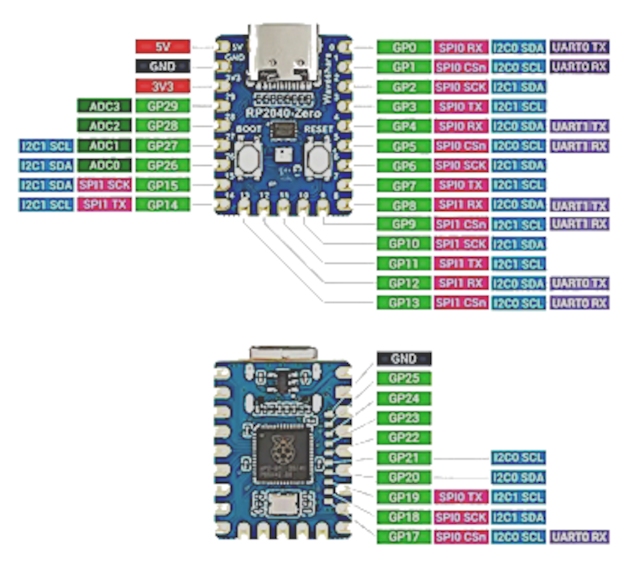Main menu
You are here
RP2040-Zero
[last updated: 2024-09-14]
MicroPython on RP2040
Thonny with RP2040
-----------------------------
This is a collection of information and procedures to get this device up and running.
I received my order of several, and am testing to see what works...
- The RP2040-Zero is a small board built around the RP2040 MCU.
It is available from Waveshare and the usual import clone sources.- Specs:
- 30 total GPIO, 4 of which can be analog
- 15 GPIO available on castellated pcb side edges
plus 6 more on the end
9 GPIO available on solder pads on bottom of board - 264 KB SRAM
- 2MB flash
- 133 MHz clock
- 2 SPI controllers
- 2v SPI controllers
- 8 PIO state machines
- 16 PWM channels
- QSPI bus controller supports up to 16 MB of external flash memory
- GPIO Voltage tolerance:
- This is squishy. The official specs apparently say that the I/O only handle 5v
- However many online reports say you can get away with connecting directly to 5v devices...
- On-board RGB LED is programmed with GP16.
- The board has two pushbuttons: "boot" and "reset"
Holding the boot PB when powering up the board puts it into "BOOTSEL" mode,
in which it will show up on your host PC as a remote USB drive.- However BEWARE because in this mode, the Only file you can transfer is the .uf2 firmware file...
- The RP2040 has a "programmable I/O" system (PIO)
that allows creating interfaces for custom hardware.- [search for "rp2" module]
- per wiki:
" ... can be programmed in assembly, C, C++, Swift, Free Pascal, Rust, Go, MicroPython, CircuitPython, Ada and TypeScript. It is powerful enough to run TensorFlow Lite."
-----------------------------
. - Specs:
- Startup:
- The Pico/Zero cannot be programmed directly from the Arduino IDE.
- First you must decide how you are going to program it, as listed above, there are several options.
I'll be using MicroPython, and have no info on any other method. - Install MicroPython on the RP2040-Zero:
- per Waveshare tutorial:
- download (onto your host PC) the pre-built release binary from the link below:
- RPI_PICO-20240602-v1.23.0.uf2
This is the latest release of the "firmware" file. - unplug all power from the zero, press and hold the boot PB, plug in the zero via USB to your host PC.
A new drive "RPI-RP2" should show up in your file manager. - drag the MicroPython [firmware].uf2 file onto the RPI-RP2 drive.
File transfer will take a few seconds,
after which the zero will reboot into MicroPython,
and the RPI-RP2 drive will disappear. - At this point the zero is running MicroPython.
However all it's doing is sitting and waiting for instructions.
Continue to:
MicroPython on RP2040
-------------------------------------------------- - Random notes:
- The "Raspberry Pi Zero" is a different board
The "Raspberry Pi Pico" is a different board, though very similar... - Problem report from some forum:
"It seems that on some units there's something slightly wrong with the crystal oscillator.
Setting PICO_XOSC_STARTUP_DELAY_MULTIPLIER to 64 in the board file helps."
-----------------------------
- The "Raspberry Pi Zero" is a different board
- Links:
- wiki for the RP2040 MCU: https://en.wikipedia.org/wiki/RP2040
- Waveshare: https://www.waveshare.com/wiki/RP2040-Zero
- Waveshare tutorial on python: https://www.waveshare.com/w/upload/b/b0/Pico_python_sdk.pdf
- https://spotpear.com/index/product/detail/id/906.html
- spotpear user guide: https://spotpear.com/index/study/detail/id/636.html
- the one I ordered: https://www.aliexpress.us/item/3256806921643389.html
- MicroPython download for pico (and zero): https://micropython.org/download/RPI_PICO/
- interesting approach to running programs... https://stackoverflow.com/questions/69271473/using-python-and-pyserial-t...
https://blog.rareschool.com/2021/01/controlling-raspberry-pi-pico-using.... - for future... SPI on python on rPi: https://learn.sparkfun.com/tutorials/raspberry-pi-spi-and-i2c-tutorial/all
- QSPI NOR memory (just one 4Mb example of many available): https://www.microchipdirect.com/product/SST25PF040C-40V/SN?samples=true
- https://community.element14.com/products/raspberry-pi/b/blog/posts/raspb...
- OLED driver on github: https://github.com/gavinlyonsrepo/SSD1306_OLED_PICO
-----------------------------------------------------------------------------------
eof

